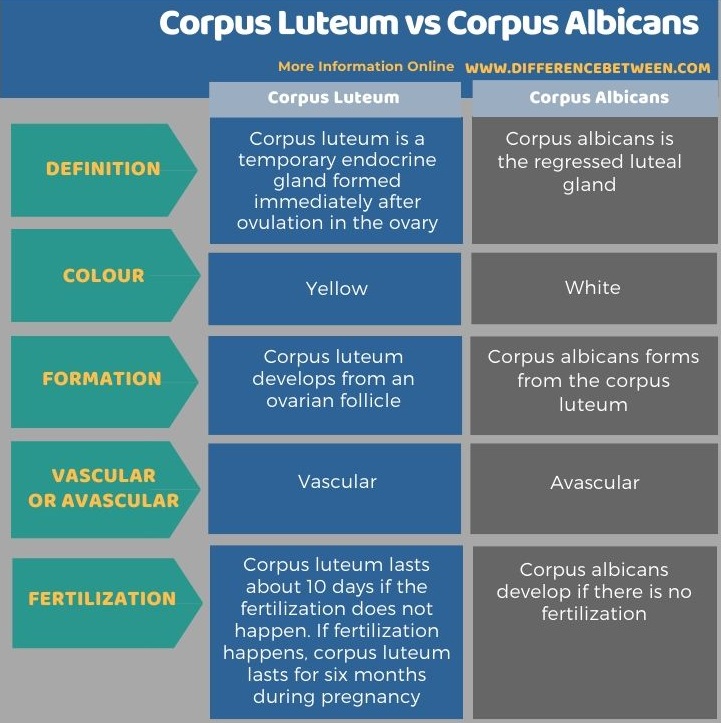Difference Between Corpus Luteum and Corpus Albicans
The key difference between corpus luteum and corpus albicans is that corpus luteum is the hormone-secreting body formed immediately after ovulation from the opened follicle while corpus albicans is the white degenerated fibrous body.
Post ovulation is the period after ovulation (release of ovum). It is also called the luteal phase. During this period, the body temperature increases, and the body prepares for implantation of a fertilized egg. The period lasts for 14 days. The open follicle closes off and forms corpus luteum. Corpus luteum is a yellow, hormone-secreting body that develops immediately after ovulation in the ovary. It is composed of lutein cells. If the ovum does not fertilize, corpus luteum degenerates into a corpus albicans. Corpus albicans is a mass of fibrous scar tissue.
CONTENTS
1. Overview and Key Difference
2. What is Corpus Luteum
3. What is Corpus Albicans
4. Similarities Between Corpus Luteum and Corpus Albicans
5. Side by Side Comparison – Corpus Luteum vs Corpus Albicans in Tabular Form
6. Summary
What is Corpus Luteum?
Corpus luteum is a yellow mass of cells that secrete hormones in the ovary. It is made up of lutein cells. Corpus luteum develops soon after ovulation when yellow pigment and lipids accumulate within the cells, lining the follicle. Corpus luteum secretes both progesterone and estrogen. Therefore, it works as a temporary endocrine gland. Granulosa lutein cells secrete progesterone while theca lutein cells secrete estrogen. Corpus luteum stops secreting hormones in the absence of fertilization. Then it degenerates into corpus albicans. Within 10 to 14 days, corpus luteum becomes inactive, and menstruation takes place. New corpus luteum forms in each menstrual cycle. The size of the corpus luteum varies widely. Sometimes, corpus luteum fills with fluid and becomes an ovarian cyst. Cysts can produce painful symptoms.

Figure 01: Corpus Luteum
If fertilization occurs, corpus luteum continues secreting progesterone during early pregnancy. Generally, it persists for six months during the pregnancy.
What is Corpus Albicans?
Corpus albicans is a white degenerated fibrous body formed by involution of corpus luteum. Therefore, it is degenerated corpus luteum or regressed luteal gland. When there is no fertilization, corpus luteum degenerates and decreases in size to form the corpus albicans. Corpus albicans is a white mass of dense connective tissue. Luteolysis is the process that describes the structural and functional degradation of the corpus luteum into corpus albicans. The corpus albicans may remain on the surface of the ovary as a scar, so it is a remnant of ovulation.

Figure 02: Corpus Albicans
Corpus albicans is frequently found in the post-menopausal ovary. Sometimes, in post-menopausal women, corpus albicans can have an abnormal appearance. This poor formation of corpus albicans is due to the decreased levels of estrogen and decreased immune-mediated phagocytic and fibroblastic activity.
What are the Similarities Between Corpus Luteum and Corpus Albicans?
- Both corpus luteum and corpus albicans are masses of cells in the ovary.
- Corpus luteum degenerates into corpus albicans.
- New corpus luteum and corpus albicans are formed during each menstruation.
- Both cell masses represent one ovulation.
What is the Difference Between Corpus Luteum and Corpus Albicans?
Corpus luteum is yellow, steroid hormone-producing cells formed following ovulation in the ovary. Corpus albicans is the fibrous body formed as a result of degeneration of corpus luteum. So, this is the key difference between corpus luteum and corpus albicans.
Moreover, another difference between corpus luteum and corpus albicans is their colour. The corpus luteum is a yellow colour mass of cells while corpus albicans is a white colour mass of cells. Furthermore, corpus luteum is a vascular body while corpus albicans is an avascular scar.
Below infographic summarizes the difference between corpus luteum and corpus albicans.

Summary – Corpus Luteum vs Corpus Albicans
Corpus luteum is a hormone-secreting mass of cells while corpus albicans is a hyaline connective tissue. Corpus luteum is formed immediately after ovulation and degenerates into corpus albicans, which is a fibrous body composed of an aggregate of dense connective tissue, in the absence of fertilization. Corpus luteum is responsible for secreting progesterone during early pregnancy. Remnants of the corpus albicans stay on the surface of the ovary as a scar. Thus, this is the summary of the difference between corpus luteum and corpus albicans.
Reference:
1. “Corpus Luteum: Function, Formation, And Cysts”. Medicalnewstoday.Com, 2020, Available here.
2. Kirkendoll, Shelbie, and Dhouha Bacha. “Histology, Corpus Albicans”. Ncbi.Nlm.Nih.Gov, 2020, Available here.
Image Courtesy:
1. “334238 1 En 7 Fig1 HTML” By Dmcmdissa – Own work (CC BY-SA 4.0) via Commons Wikimedia
2. “Corpus albicans” By Jpogi – Own work (Public Domain) via Commons Wikimedia
ncG1vNJzZmivp6x7pbXFn5yrnZ6YsqOx07CcnqZemLyue8OinZ%2Bdopq7pLGMm5ytr5Wau26vzqunrqtdocK1sdSmZJqmlGKwsL7PrqpmmZyXtqStzaxm